'Race of the Damed'
by Norman Mundy, Carey Bates, and Buz Vault
from Eerie #109, February, 1980
By 1980, the Warren magazines had become increasingly aware of the artistic influence of Heavy Metal magazine, as this art deco - inspired comic shows.
Sunday, August 11, 2013
Thursday, August 8, 2013
Heavy Metal August 1983
'Heavy Metal' magazine, August 1983
August, 1983, and in heavy rotation on the FM stations, and on MTV, is Loverboy's 'Hot Girls in Love'. Cheesy as it was back then, it's substantially better than anything in the top 40 nowadays.
The latest issue of Heavy Metal is on the stands, with a remarkably insipid front cover illustration by Greg Hildebrandt. It was now becoming quite clear that the HM editorial staff had decided to exclusively promote a pinup theme for each and every front cover, a departure from the way things were done in the first several year's of the magazine's existence. The arresting, artistic covers of 1978, 1979, and 1980 were to be faint memories from now on.
Jay Muth provides the back cover.
The advertising features a full-page ad for the latest Iron Maiden album, 'Piece of Mind'; it's an unwitting and unintentional nod to 'Spinal Tap'.
For those deeply moved by the Hildebrandt cover, posters are available:
There also is an advertisement for some film I've never heard of, called 'Private School for Girls'. Phoebe Cates does look nice.....
After its heavy coverage of rap, the Dossier now turns to R & B, and we lead off with coverage of Prince Nelson Rogers (just beginning his rapid rise to fame), and Marvin Gaye.
Then there is coverage of graffiti artist - if that's the right word - Keith Haring, one of the decade's greatest art poseurs. He would die from AIDS in 7 years.
Ed Naha waxes enthusiastic over an indie, low-budget film-maker named Alan Arkush and his film 'Get Crazy'. I've never heard of it before or since......
And the Dossier closes out with a review of some awful underground / indie comics.....
Among the comics appearing in the August issue are continuing installments of 'The City That Didn't Exist', by Bilal; 'The Odyssey' by Navarro and Sauri; 'Zora' by Fernandez.
Among the better entries was another 'El Borbah' tale by Charles Burns, that I've posted below.
August, 1983, and in heavy rotation on the FM stations, and on MTV, is Loverboy's 'Hot Girls in Love'. Cheesy as it was back then, it's substantially better than anything in the top 40 nowadays.
The latest issue of Heavy Metal is on the stands, with a remarkably insipid front cover illustration by Greg Hildebrandt. It was now becoming quite clear that the HM editorial staff had decided to exclusively promote a pinup theme for each and every front cover, a departure from the way things were done in the first several year's of the magazine's existence. The arresting, artistic covers of 1978, 1979, and 1980 were to be faint memories from now on.
Jay Muth provides the back cover.
The advertising features a full-page ad for the latest Iron Maiden album, 'Piece of Mind'; it's an unwitting and unintentional nod to 'Spinal Tap'.
For those deeply moved by the Hildebrandt cover, posters are available:
There also is an advertisement for some film I've never heard of, called 'Private School for Girls'. Phoebe Cates does look nice.....
After its heavy coverage of rap, the Dossier now turns to R & B, and we lead off with coverage of Prince Nelson Rogers (just beginning his rapid rise to fame), and Marvin Gaye.
Then there is coverage of graffiti artist - if that's the right word - Keith Haring, one of the decade's greatest art poseurs. He would die from AIDS in 7 years.
Ed Naha waxes enthusiastic over an indie, low-budget film-maker named Alan Arkush and his film 'Get Crazy'. I've never heard of it before or since......
And the Dossier closes out with a review of some awful underground / indie comics.....
Among the comics appearing in the August issue are continuing installments of 'The City That Didn't Exist', by Bilal; 'The Odyssey' by Navarro and Sauri; 'Zora' by Fernandez.
Among the better entries was another 'El Borbah' tale by Charles Burns, that I've posted below.
Labels:
'Heavy Metal' August 1983
Monday, August 5, 2013
All This and Frank Sinatra, Jr, too
All This and Frank Sinatra, Jr, too
by Drew Friedman
from the August, 1983 issue of Heavy Metal magazine
by Drew Friedman
from the August, 1983 issue of Heavy Metal magazine
Labels:
All This and Frank Sinatra
Saturday, August 3, 2013
Book Review: The Stone God Awakens
Book Review: 'The Stone God Awakens' by Philip Jose Farmer
3 / 5 Stars
‘The Stone God Awakens’ was issued in paperback by Ace Books in July, 1973, with a cover illustration by J. H. Breslow.
Artist Bruce Pennington provided a particularly well-done illustration for the (UK) Panther Books 1976 edition:
During the New Wave era, Philp Jose Farmer produced two types of novels: straightforward sf adventures primarily written for commercial purposes; and artier pieces, designed to display his aptitude at crafting ‘speculative fiction’.
‘Stone God’ belongs to the former category.
The premise is not particularly original: it’s 1985, and at Syracuse University, Ulysses Singing Bear, a biophysicist with a part- Iroquois ethnic background, is experimenting with a novel ray capable of ceasing all molecular activity in its targets.
Ulysses makes a fateful mistake and is struck by the ray. Instantly he is transformed into a man of ‘stone’, indestructible and unmoving. Time has no meaning for Singing Bear in his suspended animation.
Upon awakening, Singing Bear finds himself inside a crude temple, in the midst of a violent conflict between tribes of 'cat people', who revere him as ‘The Stone God’. Singing Bear discovers that the land around him is occupied by various other races of Manimals, all of whom operate at a stone-age level of technology. He suspects that millions of years have passed while he was in his frozen state.
Using his superior scientific knowledge, Singing Bear is able to organize the disparate tribes of Manimals into a single nation, loyal to his commands. He then embarks on a journey to discover the secrets behind Wurutana, the enormous tree, up to 13,000 feet high, with branches hundreds of yards in diameter, that covers most of the continent.
Regarded as a God by the races that live within its branches, Wurutana is gradually extinguishing what remains of civilization. Its relentless outward growth is pushing the towns and cities of all sentient races into a marginalized life at the coastland, where the salt water deters the tree from extending its roots.
Unless Ulysses Singing Bear can discover a way to defeat the tree, the Manimals of this far-future Earth will be consigned to life as nothing more than aphids, eking out an existence as parasites on the bark of a massive plant…………
At 190 pp in length, ‘Stone God’ is a quick read, and a mildly interesting sf adventure. With its unadorned, declarative prose style, it was clearly an effort by Farmer to write something that paid the bills. That said, the novel’s climax, involving an extended battle scene, is well-written, and superior in many ways to much of the dedicated New Wave fiction Farmer produced in this era.
‘The Stone God Awakens’ was issued in paperback by Ace Books in July, 1973, with a cover illustration by J. H. Breslow.
Artist Bruce Pennington provided a particularly well-done illustration for the (UK) Panther Books 1976 edition:
During the New Wave era, Philp Jose Farmer produced two types of novels: straightforward sf adventures primarily written for commercial purposes; and artier pieces, designed to display his aptitude at crafting ‘speculative fiction’.
‘Stone God’ belongs to the former category.
The premise is not particularly original: it’s 1985, and at Syracuse University, Ulysses Singing Bear, a biophysicist with a part- Iroquois ethnic background, is experimenting with a novel ray capable of ceasing all molecular activity in its targets.
Ulysses makes a fateful mistake and is struck by the ray. Instantly he is transformed into a man of ‘stone’, indestructible and unmoving. Time has no meaning for Singing Bear in his suspended animation.
Upon awakening, Singing Bear finds himself inside a crude temple, in the midst of a violent conflict between tribes of 'cat people', who revere him as ‘The Stone God’. Singing Bear discovers that the land around him is occupied by various other races of Manimals, all of whom operate at a stone-age level of technology. He suspects that millions of years have passed while he was in his frozen state.
Using his superior scientific knowledge, Singing Bear is able to organize the disparate tribes of Manimals into a single nation, loyal to his commands. He then embarks on a journey to discover the secrets behind Wurutana, the enormous tree, up to 13,000 feet high, with branches hundreds of yards in diameter, that covers most of the continent.
Regarded as a God by the races that live within its branches, Wurutana is gradually extinguishing what remains of civilization. Its relentless outward growth is pushing the towns and cities of all sentient races into a marginalized life at the coastland, where the salt water deters the tree from extending its roots.
Unless Ulysses Singing Bear can discover a way to defeat the tree, the Manimals of this far-future Earth will be consigned to life as nothing more than aphids, eking out an existence as parasites on the bark of a massive plant…………
At 190 pp in length, ‘Stone God’ is a quick read, and a mildly interesting sf adventure. With its unadorned, declarative prose style, it was clearly an effort by Farmer to write something that paid the bills. That said, the novel’s climax, involving an extended battle scene, is well-written, and superior in many ways to much of the dedicated New Wave fiction Farmer produced in this era.
Labels:
The Stone God Awakens
Thursday, August 1, 2013
Luther Arkwright and Harry Fairfax
Luther Arkwright and Harry Fairfax
by Bryan Talbot
illustration from The Adventures of Luther Arkwright No. 4
Dark Horse Comics, June 1990
Showing inspiration from such sources as Gustave Dore and William Hogarth ('Gin Lane'), the intricate pen-and-ink draftsmanship of this one-page panel by Bryan Talbot shows Harry Fairfax (left) and Luther Arkwright (right) making their way through London's Shoreditch neighborhood.
Albeit a Shoreditch in an alternate 1970s London, where Nathaniel Cromwell, the descendent of Oliver Cromwell, rules England, and Royalist sympathizers and rebels hole up in the slum warrens of Shoreditch, there conspiring to overthrow the Puritan regime, and place King Charles III on the Throne..........
by Bryan Talbot
illustration from The Adventures of Luther Arkwright No. 4
Dark Horse Comics, June 1990
Showing inspiration from such sources as Gustave Dore and William Hogarth ('Gin Lane'), the intricate pen-and-ink draftsmanship of this one-page panel by Bryan Talbot shows Harry Fairfax (left) and Luther Arkwright (right) making their way through London's Shoreditch neighborhood.
Albeit a Shoreditch in an alternate 1970s London, where Nathaniel Cromwell, the descendent of Oliver Cromwell, rules England, and Royalist sympathizers and rebels hole up in the slum warrens of Shoreditch, there conspiring to overthrow the Puritan regime, and place King Charles III on the Throne..........
Monday, July 29, 2013
Book Review: The Castaways of Tanagar
Book Review: 'The Castaways of Tanagar' by Brian Stableford
2 / 5 Stars
‘The Castaways of Tanagar’ (319 pp) was published by DAW Books in April, 1981. The cover artwork is by H. R. Van Dongen.
Thousands of years after its founding, the colony world of Tanagar sends forth an expedition to the motherworld, Earth, to see if the planet has survived the Atomic Wars. The Tanagarians discover that the Earth has survived not just the wars, but also the geological upheavals that reshaped the landscape. Civilization has re-started itself, in the form of the Eurasian republic of Macaria, where technology has reached a level equivalent to that of the 1930s.
The intellectual elite that governs the Tanagaran expedition prefers to avoid an overt re-introduction to Terran society. Instead, an Away Team is to be secretly inserted into the countries making up what used to be North Africa. The goal of the Away Team: seek ways to covertly influence Terran society, in order to set it on an accelerated path towards technological progress.
The members of the Away Team are in no sense ‘ordinary’ Tanagarans. In fact, they are criminals, who had been sentenced to indefinite periods of suspended animation as punishment for felonies, such as murder and rebellion, committed on Tanagar. In exchange for agreeing to serve on the Away Team, these ‘castaways’ of the book’s title must resign themselves to spending the rest of their lives on the fractious motherworld.
Early on in the narrative, members of the Away Team find themselves split up, and forced to rely on their wits and stratagems in order to survive. One sub-plot revolves around the adventures of Cheron Felix, who has spent 8,000 years in suspended animation; Sarid Jerome, a revolutionary; and Vito Talvar, a young man of fatalistic bent.
The other sub-plot deals with the tribulations of two officers who inadvertently find themselves stranded on Terra: Cyriac Salvador, a Tanagarian equivalent of Mr Spock; and Teresa Janeat, a young woman unused to the rigors of life outside a spacecraft.
Will the Castaways be able to integrate themselves into their host societies and begin their work of genial subversion ? Will Salvador and Janeat find their way to the secret Tanagaran redoubt in the northern wilderness of Macaria ? Or will the best-laid plans of the Tanagarians come for naught when the inheritors of the Earth realize that there are people from the stars walking among them ?
At its heart, ‘Castaways’ could have been a routine, but engaging, sf adventure. Unfortunately, author Stableford decides to turn lengthy sections of his novel into forums in which he can declaim – in the form of conversations or monologues – on ‘deep thoughts’ concerning the rise and fall of civilizations and political systems. As well, Stableford frequently expounds on the ever-present contradictions between the base nature of Man, and the promise of enlightened Humanism. These tedious discourses sap momentum from the narrative, and make reading ‘Castaways’ a less than rewarding experience.
Things do improve a bit in the last 40 pages, when a number of surprise revelations make an appearance, but these seem more than a little contrived. Throw in a utterly out-of-place episode of drug-induced, psychedelic ‘discovery’, and the inconclusive nature of the final chapters, and it’s hard to give ‘The Castaways of Tanagar’ a ‘must-have’ recommendation.
2 / 5 Stars
‘The Castaways of Tanagar’ (319 pp) was published by DAW Books in April, 1981. The cover artwork is by H. R. Van Dongen.
Thousands of years after its founding, the colony world of Tanagar sends forth an expedition to the motherworld, Earth, to see if the planet has survived the Atomic Wars. The Tanagarians discover that the Earth has survived not just the wars, but also the geological upheavals that reshaped the landscape. Civilization has re-started itself, in the form of the Eurasian republic of Macaria, where technology has reached a level equivalent to that of the 1930s.
The intellectual elite that governs the Tanagaran expedition prefers to avoid an overt re-introduction to Terran society. Instead, an Away Team is to be secretly inserted into the countries making up what used to be North Africa. The goal of the Away Team: seek ways to covertly influence Terran society, in order to set it on an accelerated path towards technological progress.
The members of the Away Team are in no sense ‘ordinary’ Tanagarans. In fact, they are criminals, who had been sentenced to indefinite periods of suspended animation as punishment for felonies, such as murder and rebellion, committed on Tanagar. In exchange for agreeing to serve on the Away Team, these ‘castaways’ of the book’s title must resign themselves to spending the rest of their lives on the fractious motherworld.
Early on in the narrative, members of the Away Team find themselves split up, and forced to rely on their wits and stratagems in order to survive. One sub-plot revolves around the adventures of Cheron Felix, who has spent 8,000 years in suspended animation; Sarid Jerome, a revolutionary; and Vito Talvar, a young man of fatalistic bent.
The other sub-plot deals with the tribulations of two officers who inadvertently find themselves stranded on Terra: Cyriac Salvador, a Tanagarian equivalent of Mr Spock; and Teresa Janeat, a young woman unused to the rigors of life outside a spacecraft.
Will the Castaways be able to integrate themselves into their host societies and begin their work of genial subversion ? Will Salvador and Janeat find their way to the secret Tanagaran redoubt in the northern wilderness of Macaria ? Or will the best-laid plans of the Tanagarians come for naught when the inheritors of the Earth realize that there are people from the stars walking among them ?
At its heart, ‘Castaways’ could have been a routine, but engaging, sf adventure. Unfortunately, author Stableford decides to turn lengthy sections of his novel into forums in which he can declaim – in the form of conversations or monologues – on ‘deep thoughts’ concerning the rise and fall of civilizations and political systems. As well, Stableford frequently expounds on the ever-present contradictions between the base nature of Man, and the promise of enlightened Humanism. These tedious discourses sap momentum from the narrative, and make reading ‘Castaways’ a less than rewarding experience.
Things do improve a bit in the last 40 pages, when a number of surprise revelations make an appearance, but these seem more than a little contrived. Throw in a utterly out-of-place episode of drug-induced, psychedelic ‘discovery’, and the inconclusive nature of the final chapters, and it’s hard to give ‘The Castaways of Tanagar’ a ‘must-have’ recommendation.
Labels:
The Castaways of Tanagar
Saturday, July 27, 2013
Wednesday, July 24, 2013
Kris Kool by Caza
'Kris Kool' by Caza
I found out about 'Kris Kool', and Caza's webpage, via the 50 watts blog, a site devoted to offbeat book design and illustration.
Caza's webpage is, of course, in French, but you can click on an English flag icon in the upper right corner to access the English language version. If you are a fan of Caza's works then be sure to check out the selection of eBooks available for download at affordable prices.
Among the older, out-of-print books available as eBooks is 'Kris Kool', Caza's first graphic novel / comic compilation. 'Kool' was published in 1970 by Eric Losfeld; printed copies are vanishingly rare. The eBook contains the entire original Kris Kool text, as well as supplemental material specially added to the eBook. [The price of 7 Euros translates into $9.00 US at current exchange rates.]
Reading Kris Kool is like stepping back in time to the late 60s and early 70s when I was a kid, and the psychedelic artwork epitomized by Peter Max (the pseudonym of German-born artist Peter Max Finkelstein) and the Beatle's film 'Yellow Submarine' were prominent.
However, even though he was just starting a career as a graphic artist, Caza's interpretation of the psychedelic art genre, as displayed in Kris Kool, is miles ahead of Peter Max.
The composition, draftsmanship, and coloration all are imaginative and pleasing to the eye.
The text of Kris Kool is in French, but it's not necessary to know the language to get some idea of the plot. Kool is a sort of male, hippie, version of Barbarella.....
Caza inserts some adept visual humor, as in this scene involving a unique sci-fi 'love doll'..........
'Kris Kool' is well worth the download, which consists of both a pdf file, and an eBook file. I use Firefox's free eBook reader to view the book on my PC, and the preinstalled Lumiread software to view the book on my Acer (Android) tablet.
Labels:
Kris Kool by Caza
Subscribe to:
Posts (Atom)

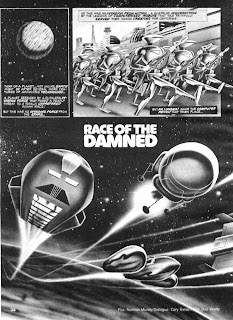






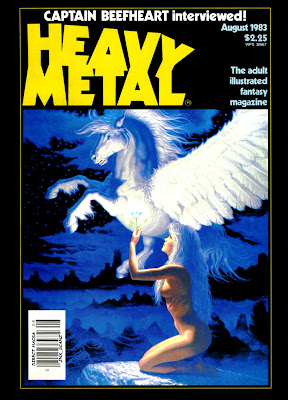















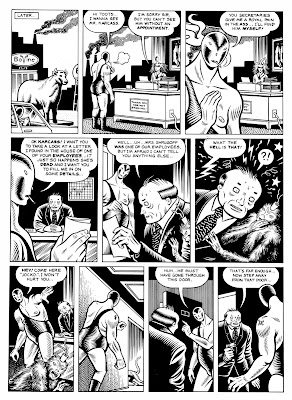





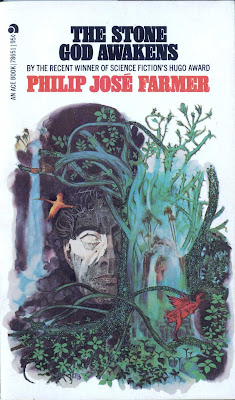
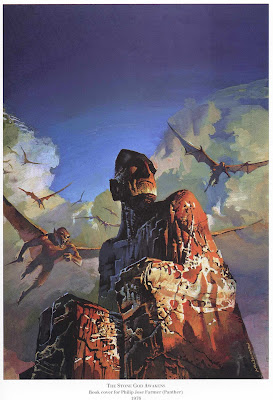




























.jpg)













